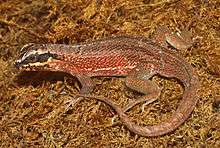Leiocephalus personatus
The Hispaniolan masked curly-tailed lizard (Leiocephalus personatus) is a lizard species from the family of curly-tailed lizard (Leiocephalidae). It is also known as the Haitian curlytail lizard[2] and the green-legged curly-tail.[3] The species is sexually dimorphic with the males being considerably larger with impressive red markings on the head around the lower jaw. Females are much smaller and are brown in colour with lighter stripes running down the flanks. The species is endemic to Hispaniola.
| Hispaniolan masked curly-tailed lizard | |
|---|---|
 | |
| Scientific classification | |
| Kingdom: | Animalia |
| Phylum: | Chordata |
| Class: | Reptilia |
| Order: | Squamata |
| Suborder: | Iguania |
| Family: | Leiocephalidae |
| Genus: | Leiocephalus |
| Species: | L. personatus |
| Binomial name | |
| Leiocephalus personatus (Cope, 1862) | |
Description
In males, the snout–vent length is 72 mm (2.8 in) with a tail of 122 mm (4.8 in). Adult males have a black face and throat, extending beyond the ear to the shoulder folds. Young males often have pale spots below and in front of the ears. The crown is brown. Older males often have a wide pale longitudinal stripe on the back as well as lateral stripes. The underparts are lightly spotted with black, including the chin, legs and rather paler tail. The female is rather smaller than the male with a snout-to-vent length of 54 mm (2.1 in) and is rather more drab in colouration, with four longitudinal pale stripes, much black barring between the stripes, and underparts heavily spotted with black.[4]
Distribution and habitat
This lizard is endemic to Hispaniola in the Caribbean Sea. It is known from various locations in Haiti and Grosse Caye, but is absent from the southwest of the Dominican Republic. It occurs at altitudes of up to about 625 m (2,000 ft). It mainly inhabits damp locations, but is also present in shaded parts of dry shrublands, including broadleaf woodland, pine forests, plantations, coastal scrub, gardens, arable land and pasture. It also occurs in urban areas, city parks and town gardens.[1] This lizard was first recorded in Florida in 1994, where it was described as a newly arrived exotic species "likely to colonize natural areas". It is restricted to several localities in Dade County.[3]
Ecology
This lizard lives on the ground and is diurnal. It feeds mainly on insects and other small arthropods, but also eats some plant material. It is probably preyed on by the small Javan mongoose (Herpestes javanicus) which has been introduced to the island.[1] A study of anti-predator behaviour among these lizards showed that those that lived in more open, exposed locations, tended to display such traits as longer limbs and faster sprint speeds.[5]
Status
Leiocephalus personatus is endemic to Hispaniola but within its limited range it is a common species and no particular threats have been identified. The population appears to be stable and the International Union for Conservation of Nature has assessed its conservation status as being of "least concern".[1]
References
- Inchaustegui, S.; Landestoy, M. (2016). "Leiocephalus personatus". IUCN Red List of Threatened Species. 2016. Retrieved 31 December 2018.CS1 maint: multiple names: authors list (link) CS1 maint: ref=harv (link)
- Leiocephalus personatus at the Reptarium.cz Reptile Database. Accessed 2 February 2019.
- Lever, Christopher (2003). Naturalized Reptiles and Amphibians of the World. Oxford University Press. p. 36. ISBN 978-0-19-850771-0.
- Cochran, D.A. (1941). "Leiocephalus personatus" (PDF). The Herpetology of Hispaniola: 212–217.
- Gifford, Matthew E.; Herrel, Anthony; Mahler, D. Luke (2008). "The evolution of locomotor morphology, performance, and anti-predator behaviour among populations of Leiocephalus lizards from the Dominican Republic". Biological Journal of the Linnean Society. 93 (3): 445–456. doi:10.1111/j.1095-8312.2007.00909.x.
Further reading
- Gifford, Matthew E.; Herrel, Anthony; Mahler, D. Luke (March 2008). "The evolution of locomotor morphology, performance, and anti-predator behaviour among populations of Leiocephalus lizards from the Dominican Republic". Biological Journal of the Linnean Society. 93 (3): 445–56. doi:10.1111/j.1095-8312.2007.00909.x.
- Gali, Frank; Schwartz, Albert (June 1982). "A New Subspecies of Leiocephalus personatus from the República Dominicana". Journal of Herpetology. 16 (2): 177–9. doi:10.2307/1563813. JSTOR 1563813.
- Schwartz, Albert (June 1971). "A New Subspecies of Leiocephalus personatus (Sauria, Iguanidae)". Herpetologica. 27 (2): 176–82. JSTOR 3891076.
- Schwartz, Albert (March 29, 1968). "The Leiocephalus (Lacertilia, Iguanidae) of Hispaniola. III. Leiocephalus schreibersi, L. semilineatus, and L. pratensis". Journal of Herpetology. 1 (1/4): 39–63. doi:10.2307/1563261. JSTOR 1563261.
- Schwartz, Albert (July 10, 1969). "Two New Subspecies of Leiocephalus from Hispaniola". Journal of Herpetology. 3 (1/2): 79–85. doi:10.2307/1563226. JSTOR 1563226.
External links
| Wikimedia Commons has media related to Leiocephalus personatus. |
